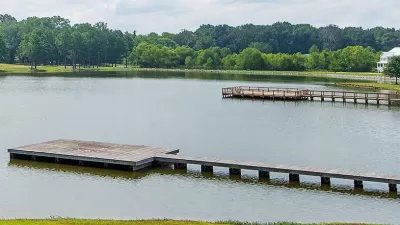If the market demand is there, why isn't more mixed-use housing getting built? Follow the money.
“This is the heart and the core, the very center of new urbanism, and it’s a difficult, messy, icky mess.”
What is Steve Maun, a developer and CNU board member, complaining about? Money, money, money. While planners and new urbanists have had their attention focused on changing zoning and coding to allow the sort of mixed-use buildings that people love, attracting financing for urbanism has remained a challenge.
The major roadblocks to financing the urban form that consumers increasingly prefer is not market demand, but decades-old government policies. The Federal Housing Administration (FHA), Fannie Mae and Freddie Mac, and HUD all have rules on the books that limit the percentage of a building that can be used for commercial space – if a federal mortgage is involved, that is. This obstructs the development of the key ingredient of traditional Main Streets; mixed use buildings with retail on the ground floor and apartments or condos above.
Maun explained all of this at a panel at CNU 21 in Salt Lake City (which can be seen in its entirety, below).
CNU and a consortium of partners, including the Regional Plan Association and the National Association of Home Builders, managed earlier this year to convince the FHA to change the limitations. “We’ve been to a lot of meetings in Washington, and you rarely get someone to lean across the table and say, ‘You know, you’re right,’” said Maun. “But this actually happened.” The revision is still officially pending, but the change in attitude is worth celebrating.
The remaining obstacle is entrenched thinking among banks and lenders. In the past, bankers considered a balance of income types in the same building as a benefit, not a drawback. Just as you balance your retirement accounts out by investing in a different investment types, having some income from housing and some from retail or office diversifies your portfolio. Today, however, mixed-use development doesn’t fit neatly into the standard real estate investment trust.
“We need to find new ways of securitizing and packaging these new loans into asset classes,” added Richard Oram, chairman of the Oram Foundation and a supporter of CNU’s efforts. “Making this happen is going to require new partnerships between Main Street and Wall Street, particularly between community banks and big banks.”
It will certainly help that the housing recovery seems to be fueled by more urban development. It was widely reported that housing starts were up 6.8% in May; what received less attention was the fact that single-family home construction was actually only up .03% -- the rest of that rise can be attributed to housing types with multiple units. The market will likely be the most convincing factor for change in the entire equation.

Study: Maui’s Plan to Convert Vacation Rentals to Long-Term Housing Could Cause Nearly $1 Billion Economic Loss
The plan would reduce visitor accommodation by 25,% resulting in 1,900 jobs lost.

Alabama: Trump Terminates Settlements for Black Communities Harmed By Raw Sewage
Trump deemed the landmark civil rights agreement “illegal DEI and environmental justice policy.”

North Texas Transit Leaders Tout Benefits of TOD for Growing Region
At a summit focused on transit-oriented development, policymakers discussed how North Texas’ expanded light rail system can serve as a tool for economic growth.

Virginia Law Allows Judges to Mandate Speed Limiters
The law could set a new precedent for speed limiting tech on U.S. vehicles.

Comment: EPA Cuts will Send Atlanta Back to Eye-burning Ozone, Lung-damaging Smog, and Raw Sewage in the Chattahoochee River
A veteran political journalist takes stock of the hard-earned ground Georgia stands to lose with slashed environmental protection.

How Community Science Connects People, Parks, and Biodiversity
Community science engages people of all backgrounds in documenting local biodiversity, strengthening connections to nature, and contributing to global efforts like the City Nature Challenge to build a more inclusive and resilient future.
Urban Design for Planners 1: Software Tools
This six-course series explores essential urban design concepts using open source software and equips planners with the tools they need to participate fully in the urban design process.
Planning for Universal Design
Learn the tools for implementing Universal Design in planning regulations.
City of Santa Clarita
Ascent Environmental
Institute for Housing and Urban Development Studies (IHS)
City of Grandview
Harvard GSD Executive Education
Toledo-Lucas County Plan Commissions
Salt Lake City
NYU Wagner Graduate School of Public Service






























